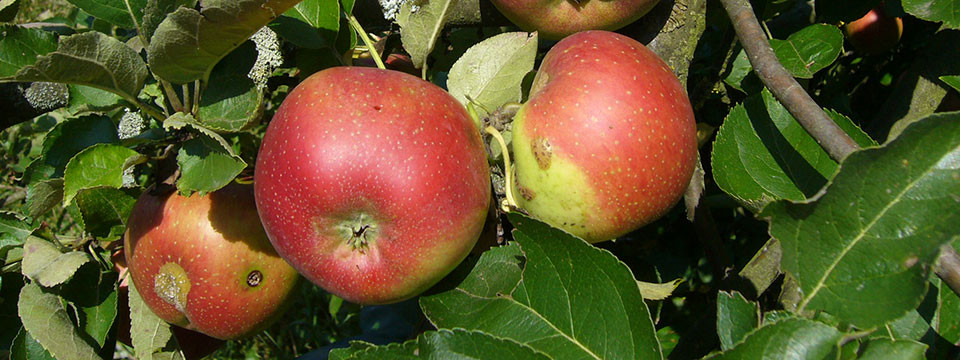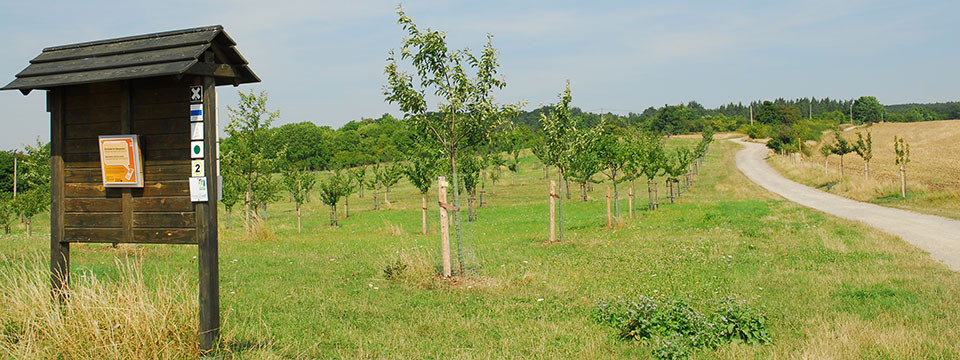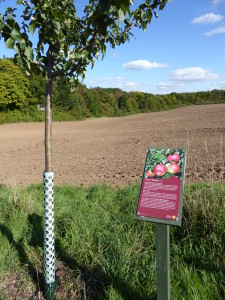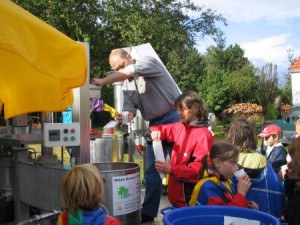Heritage Orchard
Nature Park Kyffhäuser » Heritage OrchardOrchards and their significance
Orchards are important elements in our cultural landscape. They give us fruit, beautify the countryside, play a major role in our history and provide valuable habitats for many species of plants and animals. The old fruit species typical of the region, which provided the basic stock for our orchards, are unlikely to be found in retail shops. To preserve these old and valuable cultivars, we first need information about their occurrences and their habitat requirements.
Fruit variety identification
To that end, recognized pomologists (including Dr. W. Schuricht, S. Schossig, and Dr. A. Braun-Lüllemann) worked from 1995 to 2013 to identify the species found in the nature park's region. More than 230 species were determined, including 130 apple, 40 pear, 45 cherry and 15 plum. Among the most frequently occurring species are: Querfurter Königskirsche, Kunzes Kirsche, Kassins Frühe Boskoop, Ontario, Kaiser Wilhelm, Köstliche von Charneux, Gellerts Butterbirne, Wangenheims Frühzwetsche, and Hauszwetsche. The experts also found evidence of many rare and today no longer determinable species in the nature park region such as Maibiers Parmäne, Langer Grüner Gulderling, Schöner aus Nordhausen, Tümpling, Schweizerhose, Van Marums Flaschenbirne, Türkine, Diemitzer Amarelle, Dönissens Gelbe, Porzellankirsche, Thüringer Hammelsäcke, Emma Leppermann, and Zwergmandel.
Setting up the heritage orchard
To preserve this species diversity of the Kyffhäuser region, Jürgen Pusch came up with the idea in 1999 of establishing a heritage orchard on the Schlachtberg.
The first 100 fruit trees were then planted in December 2000 in cooperation with the Kyffhäuser Nature Park Administration. In the meantime about 1,700 tall fruit trees with 700 species from all over Germany have taken root in the 15-hectare area. The wide variety makes the orchard one of the most important fruit collections in Central Germany. Because the species spectrum is so broad (apples, pears, cherries, plums, apricots, peaches, wild fruit and other fruit), it has been added to the "Bestand der deutschen Genbank Obst" (inventory of the German gene bank for fruit). Every year grafting and replanting are done to preserve and expand the species spectrum.
Fruit pressing - Mobile Juicer
In a project initiated by the Nature Park management team, a mobile juicer has been pressing the fruit from the park's orchard into high-quality juice every year since 2000. The use of the juicer has turned into an annual event for many people of the region. The juicer travels from town to town and presses apples, pears and other fruit into juice. Every user receives the juice from his/her fruit which can be kept unopened for at least one year. Since the initiative began, fruit trees have once again been maintained and harvested. These efforts help to preserve the valuable orchards in the region.
More information is available on the Website of Gutshof Hauteroda.
- 2 Klicks für mehr Datenschutz: Erst wenn Sie hier klicken, wird der Button aktiv und Sie können Ihre Empfehlung an Facebook senden. Schon beim Aktivieren werden Daten an Dritte übertragen - siehe i.nicht mit Facebook verbunden
- 2 Klicks für mehr Datenschutz: Erst wenn Sie hier klicken, wird der Button aktiv und Sie können Ihre Empfehlung an Twitter senden. Schon beim Aktivieren werden Daten an Dritte übertragen - siehe i.nicht mit Twitter verbunden
- 2 Klicks für mehr Datenschutz: Erst wenn Sie hier klicken, wird der Button aktiv und Sie können Ihre Empfehlung an Google+ senden. Schon beim Aktivieren werden Daten an Dritte übertragen - siehe i.nicht mit Google+verbunden





